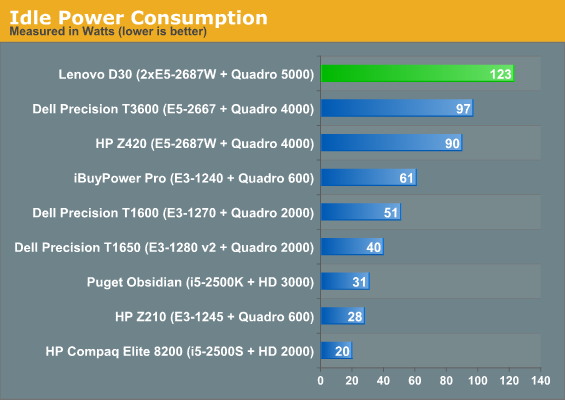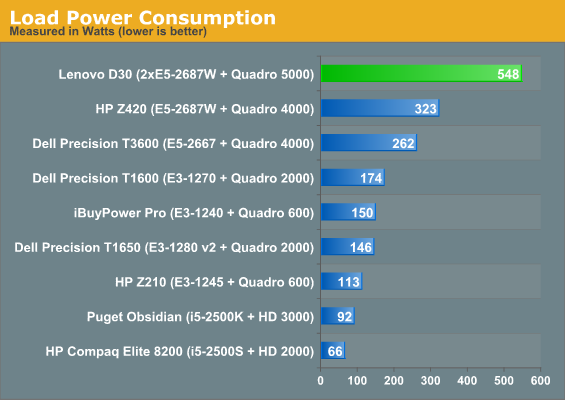Lenovo ThinkStation D30 Workstation Review: 16 Cores and 32 Threads Under Your Desk
by Dustin Sklavos on November 15, 2012 12:01 AM EST- Posted in
- Systems
- Lenovo
- Quadro
- Workstation
- Sandy Bridge E
- Enterprise
- Octalcore
Build Quality
Speaking candidly, Lenovo's internal design for the ThinkStation D30 may be at least somewhat competitive with HP's Z820's interior, but it's worlds behind Dell's Precision T7600. The design philosophy Dell rolled out with the T3600, T5600, and T7600 is probably the most thoughtful and detailed one I've seen in the workstations I've tested; Lenovo's interior in the D30 is comparably very staid and even a bit archaic in some respects.
.jpg)
For starters, the cable management is pretty poor for a system like this. For comparison's sake, below is the interior layout of the smaller Dell T3600. This isn't the most fair comparison since the D30 is a deeper case and has to support two processors, but I think the decisions involved in the design come across well enough.
.jpg)
Quite frankly, Dell's design is just cleaner. A lot of this owes to the modular power supply design they're using in their modern workstations; power supplies are designed to be easily removed and replaced out of the back of the case by the end user. Meanwhile, Lenovo's design still has a mess of cables spewing out of the back of the power supply. It's just sloppy, and worse, if the PSU goes, that's going to mean a tremendous amount of downtime.
Noise, Heat, and Power Consumption
Unfortunately HWMonitor flipped its lid trying to read the operating temperatures of the D30, but monitoring the system under load with AIDA64 revealed generally reasonable thermal performance. Noise was also for the most part a non-issue as it often is with these workstations, which is really impressive when you think about it. Lenovo was able to keep the noise level below the 30dB floor of my sound meter at idle, and then under load it peaked at a noticeable but still very tolerable 34.5dB from a foot away.
As for power consumption, it goes without saying that the D30 is going to be a bit of a monster. The combined rated wattage of the CPUs and GPU is 452W on its own, and that's ignoring the eight DIMMs and 15K-RPM mechanical hard drive.


It takes a lot of juice to sit at the top of the charts, but when you're pushing for as much raw performance as you can get (as you would with a system like this one), power consumption is really going to be a secondary concern.
.jpg)










68 Comments
View All Comments
philipma1957 - Thursday, November 15, 2012 - link
please all this money and you tested with 2x 60gb ssd's why not test with 2x 256gb samsung 830's ssd's.Zink - Thursday, November 15, 2012 - link
That's not what it says."I grabbed a spare 60GB OCZ Vertex 3 I had laying around"
Sounds like a reasonable test to see if there is a storage bottleneck. Whatever you thought should have happened with multiple SSD's sounds like a waste of money anyway.
Samus - Thursday, November 15, 2012 - link
Exactly. He mentioned the 60GB SSD had little to no impact on anything but the PCMARK Suite which is disk-intensive, so no need to test with a faster/larger SSD.However, in defense of Lenovo (and HP,) Dell has been plagued with capacitor quality problems for nearly a decade from the top-down. I've had so many PERC controllers and workstation/server motherboards fail in one way or another, always traced down to a bad $1.00 capacitor.
Have never had this happen with an HP or Lenovo workstation.
When the "bad cap scandal" began un 2001, HP had completely purged its supply by 2004, as did Lenovo in 2005. Dell NEVER required its primary suppliers (Foxconn mostly) purge their supplies and refresh with genuine Japanese (or at least quality Taiwanese) caps from Rubycon, Sanyo, Panasonic, and Chemicon. The problem is Chemicon (and Nichicon) have so many counterfeits that it's risky to stock them. Case in point, there are lots of reports of Nichicon caps actually being Nichilon (knockoff name) caps from China.
I replaced a SC440 motherboard in a server a few weeks ago manufactured in 2007 that had a number of bulging CapXon caps around the MOSFETs. A PERC 6ir controller with a bad KZG cap preventing array detection, manufactured in 2008. It cost $1 to replace the cap with a genuine Panasonic equal, but it cost the client an entire day without a server and $300 for my services (beats ordering a new $400 card from Dell with another faulty cap.
HP isn't completely clear, though. I find numerous low quality OST or underrated caps in their printers and low-end desktops. Seriously, the HP PhotoSmart C6280/C7280 (only difference is a duplexer) and various other model printer based on the same design from 2007-2008 were built using good Panasonic caps that were rated at 10v and installed into a 12v circuit. It's amazing many of these printers run for years before having carriage malfunctions or dropping wifi connections. Again, $4 in caps fixes an otherwise good multi-hundred dollar printer, especially worth it if you've stocked up on ink for them.
Many Samsung LCD's from 2006-2007 have known power capacitor problems preventing them from powering on. The 35v 1000uf is used where a 50v 1000uf would have been more appropriate, although the real issue was it being a non-FM cap so it electrical noise caused them to fail prematurely. A huge class-action lawsuit covered HDTV's, but people with LCD monitors were left out to dry.
As well as Dell's are designed, their quality issues are reflected in their bottom-dollar prices. I know mobo's use solid poly caps in vital areas now, but dude, it's still a Dell.
Haribol - Tuesday, November 20, 2012 - link
Interesting. So you are better of with a D30. I have personally used D20 for the past few years and never had any problems with hardware. I am looking for a new D30 machine to upgrade to. Lenovo website has ridiculous prices which I will never pay. I am shopping around to see where I can get the best deal. I saw a few deals on eBay and CDW. Hopefully they have a sale soon. I will post a review once I get the machine hopefully soon.seanleeforever - Monday, November 19, 2012 - link
i know anand has said a lot about the life expectancy of SSDs and how 840 with its TLC should last 7 years with light use (which is about 10G write data per day). However, it is absolutely importantly to know your HDD has a lot of activities going on in the background even with your system is idle.look no further than open your windows resource manager and check the disk use.
at this very moment, i have 3 pdf open, outlook open, 2 firefox tab open, one IE open, and anti virus. i have absolutely nothing else turned on and my disk is seeing 50 KB/S disk write at the lowest. even at the lowest level, i am expected to write 4G of data everyday when my computer is idle.
i do believe anand's SSD life expectancy analysis is somewhat flawed because it failed to include necessary disk writes as part of OS. while 10G write data per day seem to be a large number, it actually isn't. when i start doing video encoding, i can easily break the 10G data cap in at little as few minutes. check it your yourself.
therefore, if my server is to be expected seeing a lot of data processing and rendering, i can say for a fact that i would be very concerned using anything but SLC. if i were to provide 3 or 5 year warranty for my system, i would not use SSD.
vailr - Thursday, November 15, 2012 - link
Seems to be configured much like an updated 2013 Mac Pro.Whenever that machine gets released by Apple, maybe a 4-way comparison between similarly configured HP, Dell, Lenovo & Apple Mac Pro workstation-class machines could be reviewed?
afkrotch - Wednesday, November 21, 2012 - link
Except that no one cares about the Mac Pro. People buying these workstations, aren't buying Apple ones.vFunct - Thursday, November 15, 2012 - link
yes the real competitor to this in the media space is the Mac Pro.We shall see next year when Apple updates the design for their professional workstations, how these machines stack up against them.
Really the Mac Pro is king of media.. you can pretty much run any Windows/Linux software via virtualization, while having access to the exclusive Apple software like Final Cut Pro X.
Dustin Sklavos - Thursday, November 15, 2012 - link
Joke's on you, FCPX landed with a thud. Premiere CS5 onward even handle old FCP7 projects better than FCPX does.Apple is a virtual non-starter in the enterprise desktop market, and the fact that it's taking them so long to refresh the Mac Pro should be evidence enough of that.
melgross - Thursday, November 15, 2012 - link
These aren't desktop machines, in case you haven't noticed. Apple does very well in the workstation market there Mac Pro's are aimed at. It's Apple that has been distracted these past two years. Hopefully that will change next year.Apple's enterprise sales for Mac's rose 56% last year, compared to an 8% drop in Windows sales to that space. Don't count them out.
FCPX is better than your limited knowledge of it suggests, and not that many editors have run to Adobe. Apple has been adding the features that hadn't made it into the first release. It took the original FCP over a year to gain all the pro features needed as well. Those using the older version are mostly waiting for Apple to complete these updates.